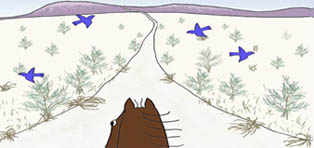NPR.org - Full Article
March 31, 20197:43 AM ET
It's the boom times in Mammoth Lakes, Calif., which is wrapping up a winter of record snowfall. Eager to take advantage of it, Donovan Sliman and his two young daughters are lumbering up a snowy trail on the outskirts of town, where the condos give way to National Forest.
"I like to get away from everybody else," says Donovan. "I like to hear the sound of the wind and the snow through the trees." "We're also going to go sledding," adds Grace, one of his daughters.
Mammoth is completely surrounded by protected federal wilderness or U.S. Forest Service land. Its destination ski resort operates on public land via a federal lease.
The Slimans try to visit the Mammoth Lakes area from their home in Orange County at least a half dozen times a year.
They're not alone.
Every year, more than 2 million people descend on California's eastern Sierra region to camp, hike, fish, hunt and ski. This region, often dubbed "the wild side" of the state, only has about 50,000 residents across two sprawling counties roughly the size of Massachusetts.
Visits up, funding down
Across the western U.S., towns surrounded by public lands are facing an increasing bind: They're seeing a huge surge in visitors coming to play in the forests and mountains surrounding them, which is leading to an economic boom. But, at the same time, federal funding to manage these lands has been drying up...
Read more here:
https://www.npr.org/2019/03/31/708051277/on-public-lands-visitors-surge-while-federal-management-funds-decline

No comments:
Post a Comment